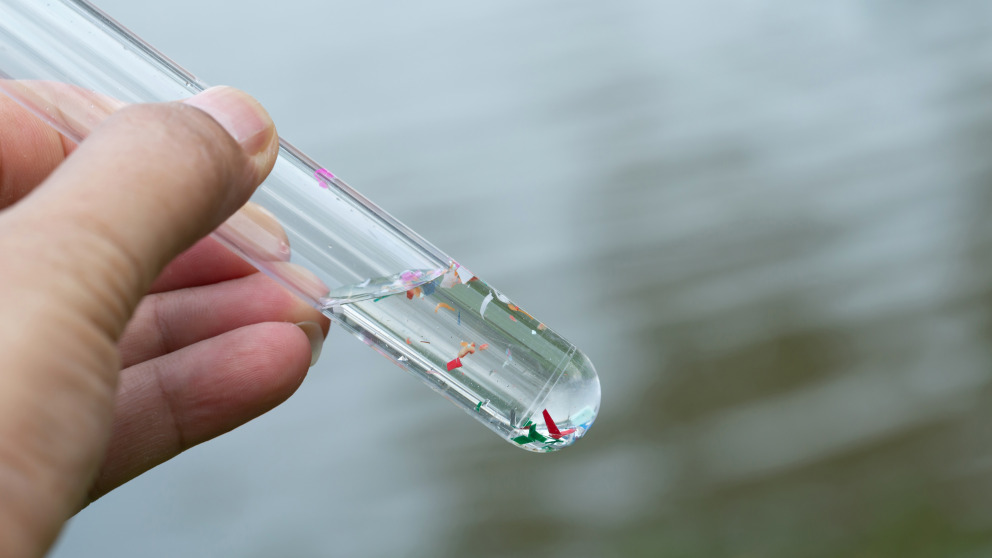Airborne Micro- and Nanoplastics Pollute Oceans
10.05.2022
A new study by an international team of researchers finds that the atmosphere is a significant source of plastic pollution in water bodies.

Scientists anticipate that plastic pollution will continue to rise and will reach levels as high as 80 million tons per year by 2040. Plastic particles have now been detected in almost all areas of the environment, including in water, soils, and the atmosphere. Carried by ocean currents or rivers, small plastic particles have been discovered in the Arctic, Antarctica, and the deep sea. A new study shows that wind can also transport small plastic particles over long distances – and much faster than water: airborne plastic particles can reach even the most remote places on Earth within a matter of days. How microplastics enter the atmosphere and the path they take is described by an international research team in the journal Nature Reviews Earth and Environment. The team of authors includes researchers from the Alfred Wegener Institute, the IASS and GEOMAR Helmholtz Centre for Ocean Research Kiel.
Between 0.013 and 25 million tons of micro- and nanoplastics are currently transported thousands of kilometres across countries, continents, and oceans each year by ocean air currents, snow, sea spray, or fog. This is the estimate of an international team of 33 researchers, including scientists from the Alfred Wegener Institute, Helmholtz Centre for Polar and Marine Research (AWI), the Institute for Advanced Sustainability Studies, Potsdam (IASS) and GEOMAR Helmholtz Centre for Ocean Research Kiel.
“Air is a much more dynamic medium than water,” says co-author Dr Melanie Bergmann of AWI. “This facilitates the transport of micro- and nanoplastics to some of the remotest and most untouched parts of our planet.” There, the particles can affect the surface climate and impact the health of ecosystems. If darker particles are deposited on snow and ice, for example, they affect ice-albedo feedback, reducing the reflection of solar radiation and causing snow and ice to melt. Darker ocean surfaces, in turn, absorb more solar energy, further heating the oceans. Microplastic particles in the atmosphere can also act as condensation nuclei for water vapor, affecting cloud formation and, in the long term, the climate.
How do plastic particles get into the atmosphere?
Human activity is a major source of airborne microplastics. Particles released through vehicle tyre and brake abrasion or with exhaust gases from industrial processes enter the atmosphere and are transported further by air flows. However, according to the study, there is evidence to suggest that significant quantities of particulate matter are also transported via the marine environment. Initial studies suggest that microplastics from the coastal zone enter the ocean as a result of beach erosion. Sea spray, wind, and waves create air bubbles in the water that encapsulate microplastics. The particules are subsequently released into the atmosphere when the bubbles burst. The transport of microplastics to remote and polar regions could be due to a combination of atmospheric and marine transport.
This makes it important to understand the interactions between the atmosphere and the ocean in order to determine the size and quantity of microplastic particles trasnported by these means. The atmosphere is also an important transport pathway for smaller microplastic particles, which travel faster, and can deposit significant quanities of microplastics in different ecosystems. Melanie Bergmann explains: “We need to integrate micro- and nanoplastics into our air pollution monitoring, and we should preferably do this right away on an international scale through existing global networks.” As a first step, study lead author Deonie Allen and Melanie Bergmann began sampling microplastics in the air, seawater, and ice for this purpose during an expedition to the Arctic last year.
Understanding the microplastic cycle through cooperation
More collaborative efforts are needed to better understand and characterize the microplastic cycle between the ocean and the atmosphere. The research team, which was led by Deonie Allen and Steve Allen of the University of Strathclyde, Glasgow, outlines in the study a global strategy for the development of a cohesive common dataset to track the flux of micro- and nanoplastics between the ocean and atmosphere. “There are so many aspects we still don’t know about the emissions, transport and effects of microplastics in the atmosphere,” said co-author Prof. Dr Tim Butler of the IASS. “This publication lays out the knowledge gaps - and charts a path forward.”
Two dedicated working groups of the Joint Group of Experts on the Scientific Aspects of Marine Environmental Protection (GESAMP) developed the study. Co-author of the study and GESAMP member, Prof. Dr Sylvia Sander from GEOMAR says: “What this study shows is that it is only by bringing together researchers and their data that we can gain a deeper understanding of the ocean, and the impact of human influences on it. The greatest and most urgent challenges of our time are unfolding at the global level. Tackling them requires that we gather the most comprehensive international expertise possible – cooperation is essential.” GESAMP operates under the auspices of eleven United Nations organisations and seeks to develop a multidisciplinary, scientific understanding of marine ecosystems and human activities that affect them. It has collaborated with more than 500 scientists from various countries on a range of issues.
The presence of micro- and nanoplastics in the air also impacts human health. In a recent British study, microplastics were detected in 11 out of 13 lungs of living people. “This is another reason why we should include plastics in air quality monitoring programmes,” Melanie Bergmann emphasizes. In a letter to the journal Science, Bergmann and other experts recently called for the production of new plastic to be gradually reduced as part of an international agreement in order to reduce the amount of plastic entering the environment.
Publication:
Deonie Allen et al.: Micro- and nanoplastics in the marine-atmospheric environment. Nature Reviews Earth & Environment (2022). DOI: https://doi.org/10.1038/s43017-022-00292-x

